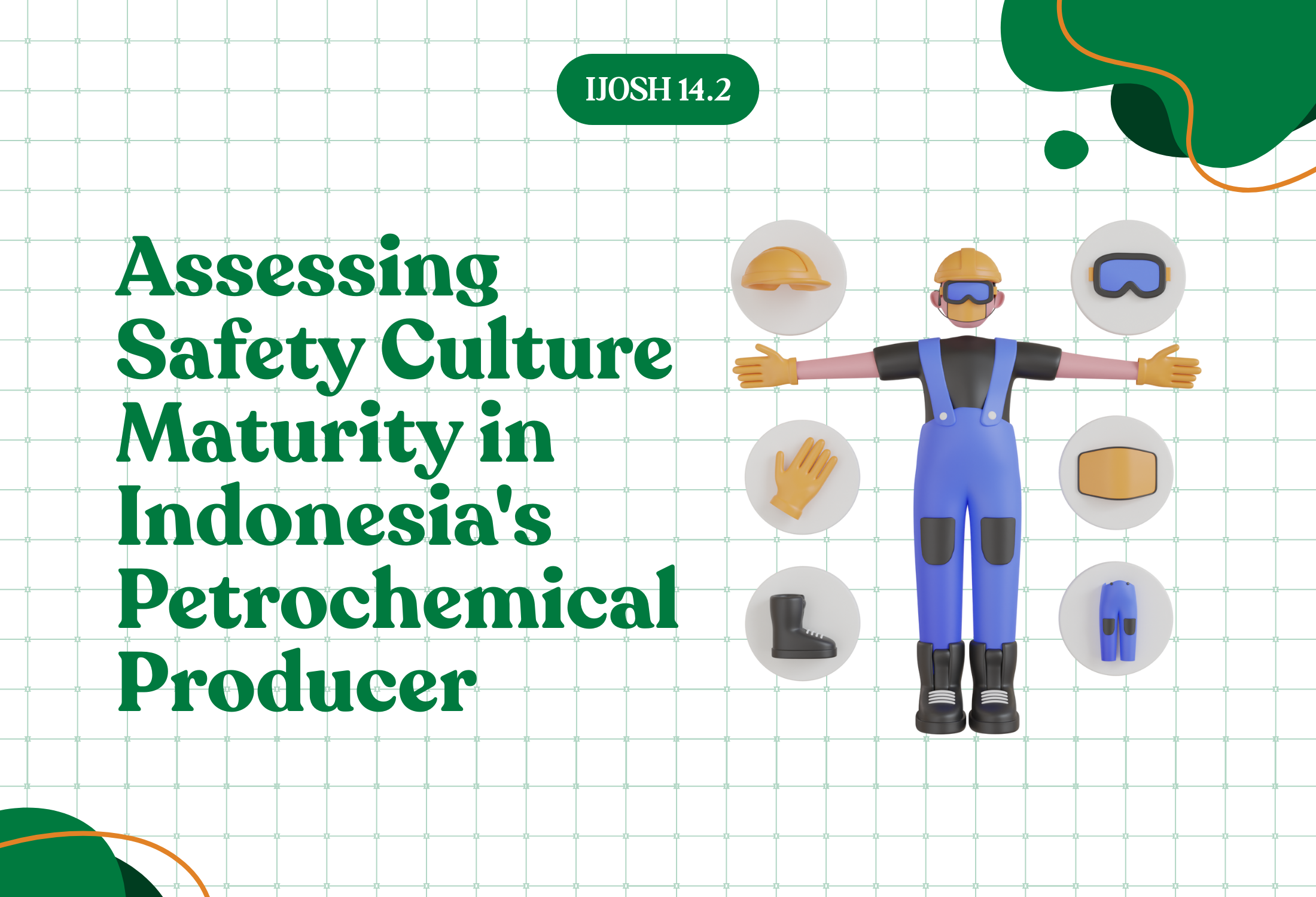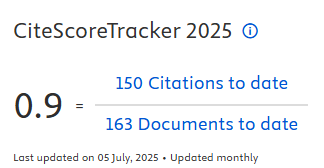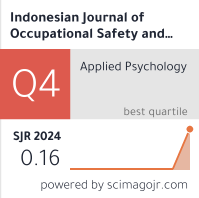Assessing Safety Culture Maturity in Indonesia's Petrochemical Producer

Downloads
Introduction: Safety culture maturity is essential in high-risk industries, including the petrochemical sector, where maintaining workplace safety helps prevent accidents and improve operational efficiency. This study explores the maturity level of safety culture at the petrochemical company in Indonesia using Hudson’s five stage maturity model as a framework for evaluation. The research aims to identify the correlation between safety culture maturity and five aspects of organizational factors. Methods: The questionnaire was completed using online survey-based research by the employees in a petrochemical company of 86 respondents selected through purposive sampling. Safety culture maturity served as the dependent variable, while the independent variables included five organizational factors: information, organizational learning, employee participation, communication, and commitment. The study considers safety culture maturity as the dependent variable, while the five organizational factors serve as independent variables. Data were analyzed using regression analysis Spearman’s correlation to assess between these factors and the maturity level of safety culture. Results: The results from the framework demonstrating the safety culture maturity at the level of generative. The strongest correlations were found in commitment (r = 0.712, p < 0.01), followed by information, organizational learning, employee participation, and communication. Meanwhile, gender and education level did not significantly influence safety culture maturity. Conclusion: These findings highlight the importance of organizational commitment, effective communication, and continuous learning make the safety culture become the habit. The study recommended the petrochemical industries using the framework and revised the questionnaire align with the regulation for continuous improvement in safety culture.
Al-Bayati, A.J. (2021) ‘Impact of Construction Safety Culture and Construction Safety Climate on Safety Behavior and Safety Motivation’, Safety, 7(2), p. 41. Available at: https://doi.org/10.3390/safety7020041.
Alshemeri, R. and Bugawa, A. (2023) ‘Critical Success Factors for Innovation Management in Regional Joint Ventures: A Study of Gulf Petrochemicals Industries Company.’, Multi-Knowledge Electronic Comprehensive Journal For Education & Science Publications (MECSJ) [Preprint], (66). Available at: https://mecsj.com/uplode/images/photo/Critical_Success_Factors_for_Innovation_Management__.pdf.
Amirah, N.A. et al. (2024) ‘Fostering a Safety Culture in Manufacturing through Safety Behavior: A Structural Equation Modelling Approach’, Journal of Safety and Sustainability, 1(2), pp. 108–116. Available at: https://doi.org/10.1016/j.jsasus.2024.03.001.
Bai, M. et al. (2023) ‘Why do Major Chemical Accidents Still Happen in China: Analysis from a Process Safety Management Perspective’, Process Safety and Environmental Protection, 176, pp. 411–420. Available at: https://doi.org/10.1016/j.psep.2023.06.040.
Baldelovar, M. and Kumar, P.V.S. (2022) ‘Role of It in Increasing the Value of Cross-Organizational Knowledge Management’, Technoarete Transactions on Advances in Computer Applications, 1(2), pp. 34-41.
Behari, N. (2019) ‘Assessing Process Safety Culture Maturity for Specialty Gas Operations: A Case Study’, Process Safety and Environmental Protection, 123, pp. 1–10. Available at: https://doi.org/10.1016/j.psep.2018.12.012.
Bentoy, M. et al. (2022) ‘Complex Cause-effect Relationships of Social Capital, Leader-member Exchange, and Safety Behavior of Workers in Small-medium Construction Firms and the Moderating Role of Age’, Sustainability, 14(19), p. 12499. Available at: https://doi.org/10.3390/su141912499.
Boskeljon‐Horst, L., Sillem, S. and Dekker, S.W.A. (2023) ‘“Ladder”‐based Safety Culture Assessments Inversely Predict Safety Outcomes’, Journal of Contingencies and Crisis Management, 31(3), pp. 372–391. Available at: https://doi.org/10.1111/1468-5973.12445.
Çakıt, E. et al. (2019) ‘Assessment of the Perceived Safety Culture in the Petrochemical Industry in Japan: A Cross-sectional Study’, PLoS One, 14(12), p. e0226416. Available at: https://doi.org/10.1371/journal.pone.0226416.
Coelho, M.B. et al. (2023) ‘Project Management Efficiency Measurement with Data Envelopment Analysis: A Case in a Petrochemical Company’, Applied System Innovation, 7(1), p. 2. Available at: https://doi.org/10.3390/asi7010002.
Dreval, Y.D. et al. (2020) ‘Fundamental Principles of Activity of International Labour Organization in Occupational Safety and Hygiene’, Environmental Safety, Labour Protection, 6, pp. 89-96 . Available at: https://doi.org/10.33271/nvngu/2020-6/089.
Duarte, F. et al. (2023) ‘Safety Culture Assessment and the Transformation of Practices’, Safety Management and Human Factors, 105(105). Available at: https://doi.org/10.54941/ahfe1003067.
Fassio, F. et al. (2022) ‘Health Status of Petrochemical Workers: A Narrative Review’, Giornale Italiano di Medicina del Lavoro ed Ergonomia, 44(1), pp. 51–58. Available at: https://hdl.handle.net/11571/1468771.
Greeff, M. (2023) The Empirical Design of a Safety Culture Maturity Development Model. Marcell Greeff.
Halonen, T. and Liukkunen, U. (2021) International Labour Organization and Global Social Governance. Helsinki: Springer Nature. Available at: https://doi.org/10.1007/978-3-030-55400-2.
Hudson, R. (2009) ‘Measuring maturity’, The Sage Handbook of Writing Development, pp. 349–362.
Jule, J.G. (2020) ‘Workplace Safety: A Strategy for Enterprise Risk Management’, Workplace Health & Safety, 68(8), pp. 360–365. Available at: https://doi.org/10.1177/2165079920916654.
Knode, T. (2020) ‘A New Way of Looking at Safety Culture Maturity Models-the Lens of Employee Engagement’, in SPE Annual Technical Conference and Exhibition? SPE, p. D041S057R004. Available at: https://doi.org/10.2118/201259-MS.
Kunt, T. et al. (2024) ‘Maturity Model Approach for Building Effective Process Safety Management Systems’, Process Safety Progress, 43(2), pp. 233–238. Available at: https://doi.org/10.1002/prs.12543.
Magalhães, M.C.-R., Jordão, F. and Costa, P. (2022) ‘The Mediator Role of the Perceived Working Conditions and Safety Leadership on the Relationship between Safety Culture and Safety Performance: A Case Study in a Portuguese Construction Company’, Análise Psicológica, 40(1), pp. 81–99. Available at: https://doi.org/10.14417/ap.1899.
Melberg, K. and Gressgård, L.J. (2023) ‘Digitalization and Changes to Work Organization and Management in the Norwegian Petroleum Industry’, Cognition, Technology & Work, 25(4), pp. 447–460. Available at: https://doi.org/10.1007/s10111-023-00739-1.
Narayanan, D.K. et al. (2023) ‘Hazards in Oil, Gas, and Petrochemical Industries’, in Crises in Oil, Gas and Petrochemical Industries, pp. 71–99. Available at: https://doi.org/10.1016/B978-0-323-95154-8.00010-4.
Orlando, A.G.S., Lima, G.B.A. and Abreu, C.G.S. (2019) ‘Assessment of Maturity Level: a Study of QHSE Culture’, Revista Produção e Desenvolvimento, 5(1), p. 357. Available at: https://portal.amelica.org/ameli/journal/167/1671501012/html/.
Pei, J. et al. (2023) ‘Research on the Maturity Evaluation Model of Enterprise Safety Culture’, International Journal of Environmental Research and Public Health, 20(3), p. 2664. Available at: https://doi.org/10.3390/ijerph20032664.
Perks, R. and Schulz, K. (2020) ‘Gender in Oil, Gas and Mining: An Overview of the Global State-of-Play’, The Extractive Industries and Society, 7(2), pp. 380–388. Available at: https://doi.org/10.1016/j.exis.2020.04.010.
Rahim, H. et al. (2024) ‘Decoding Stakeholder Priorities of Safety Culture Preferences in the Oil and Gas Industry’, Scientific Reports, 14(1), p. 20735. Available at: https://www.nature.com/articles/s41598-024-71294-6.
Shinkevich, A.I. et al. (2019) ‘Reserves for Improving the Efficiency of Petrochemical Production on the Basis of “Industry 4.0”’, in E3S Web of Conferences. EDP Sciences, 124, p. 04006. Available at: https://doi.org/10.1051/e3sconf/201912404006.
Syaifullah, D.H. (2024) ‘The Impacts of Safety on Sustainable Production Performance in the Chemical Industry’. Thesis. Convertry: Coventry University. Available at: https://pure.coventry.ac.uk/ws/portalfiles/portal/99387978/Final_Thesis_Danu_Syaifullah_Redacted.pdf.
Tetzlaff, E.J. et al. (2021) ‘Safety Culture: A Retrospective Analysis of Occupational Health and Safety Mining Reports’, Safety and Health at work, 12(2), pp. 201–208. Available at: https://doi.org/10.1016/j.shaw.2020.12.001.
Todaro, N.M. et al. (2023) ‘Safety Climate in High Safety Maturity Organisations: Development of a Multidimensional and Multilevel Safety Climate Questionnaire’, Safety science, 166, p. 106231. Available at: https://doi.org/10.1016/j.ssci.2023.106231.
Trinh, M.T. and Feng, Y. (2022) ‘A Maturity Model for Resilient Safety Culture Development in Construction Companies’, Buildings, 12(6), p. 733. Available at: https://doi.org/10.3390/buildings12060733.
Vashishth, T.K. et al. (2024) ‘Industry 4.0 Trends and Strategies: A Modern Approach with Focus on Knowledge Management’, Knowledge Management and Industry Revolution 4.0, pp. 111–158. Available at: https://doi.org/10.1002/9781394242641.ch5.
Wicaksono, F.D. et al. (2021) ‘Statistical Analysis of the High Potential Incident in Andals Oil of Indonesia’, Jurnal Teknologi, 83(2), pp. 1–13. Available at: https://doi.org/10.11113/jurnalteknologi.v83.14884.
Widowati, E. et al. (2024) ‘Analysis of Occupational Accidents in Various Informal Sectors in Indonesia’, Unnes Journal of Public Health, 13(2), pp. 50–56. Available at: https://doi.org/10.15294/ujph.v13i2.4370.
Williams, J., Fugar, F. and Adinyira, E. (2020) ‘Assessment of Health and Safety Culture Maturity in the Construction Industry in Developing Economies: A Case of Ghanaian Construction Industry’, Journal of Engineering, Design and Technology, 18(4), pp. 865–881. Available at: https://doi.org/10.1108/JEDT-06-2019-0151.
Xu, J. et al. (2023) ‘Implementing Safety Leading Indicators in Construction: Toward a Proactive Approach to Safety Management’, Safety science, 157, p. 105929. Available at: https://doi.org/10.1016/j.ssci.2022.105929.
Yeshitila, D., Kitaw, D. and Jilcha, K. (2021) ‘Applying Lean Thinking to Improve Operational Safety in Oil and Gas Industry’, Open Journal of Safety Science and Technology, 11(3), pp. 120-141. Available at: https://doi.org/10.4236/ojsst.2021.113009.
Zara, J., Nordin, S.M. and Isha, A.S.N. (2023) ‘Influence of Communication Determinants on Safety Commitment in a High-risk Workplace: A Systematic Literature Review of Four Communication Dimensions’, Frontiers in Public Health, 11. Available at: https://doi.org/10.3389/fpubh.2023.1225995.

This work is licensed under a Creative Commons Attribution-NonCommercial-ShareAlike 4.0 International License.

In order to be accepted and published by The Indonesian Journal of Occupational Safety and Health, Author(s) who submit an article should complete all the review process. The copyright of received articles assigned to the The Indonesian Journal of Occupational Safety and Health and Department of Safety and Health, Universitas Airlangga as publishers of the journal. The intended copyright includes the rights to publish articles in various forms (including reprints).
The Editorial Team of The Indonesian Journal Of Occupational Safety and Health and Department of Safety and Health strive to ensure that no errors occur in the articles that have been published, both data errors and statements in the article.
Users of this website will be licensed to use materials from this website following the Creative Commons Attribution-NonCommercial-ShareAlike 4.0 International License. No fees charged. Please use the materials accordingly.
------------------------------------------------------------------------------------------------------------------------------------------------------------------------------------------
Attribution ” You must give appropriate credit, provide a link to the license, and indicate if changes were made. You may do so in any reasonable manner, but not in any way that suggests the licensor endorses you or your use.
NonCommercial ” You may not use the material for commercial purposes.
ShareAlike ” If you remix, transform, or build upon the material, you must distribute your contributions under the same license as the original.







 How to Submit Articles in OJS
How to Submit Articles in OJS

























